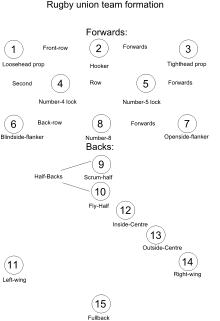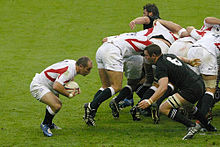- Flanker (rugby union)
-
For other uses, see Flanker.
 An example rugby union team formation illustrating the players relative positions.
An example rugby union team formation illustrating the players relative positions.
A flanker is a position in the sport of rugby union. Flankers play in the forwards,[1] and are generally classified as either blindside, or openside flankers; numbers six and seven respectively. The name comes from their position in a scrum in which they flank each set of forwards. The set responsibilities of flankers are fewer than all other forwards in a rugby team, but generally consists of retaining and gaining possession in the various phases of play in a match—most commonly in rucks and mauls. Flankers also assist in pushing in a scrum, but are expected to detach from the scrum as early as possible in order to get to play before the opposition's forwards. Flankers also participate in line-outs, either being lifted to contest or win possession, or to lift other players. Rugby flankers are expected to make most of the tackles. When a team wins the scrum the flanker is expected to support their players by running behind and rucking over for their team to keep possession.[1]
Like other forward positions, flankers put more emphasis on strength than on speed.
Contents
Naming
 Diagram of scrum formation in rugby union; note the flankers, numbered six and seven are on the flanks of the two forward packs.
Diagram of scrum formation in rugby union; note the flankers, numbered six and seven are on the flanks of the two forward packs.
Flankers can be known by several different names. Historically they were often called wing-forwards, although this name had a more specific meaning in New Zealand when they used a now archaic scrum formation.[2] This term is rarely used anymore, but the terms breakaway, flank, and flank forward are sometimes used. Collectively the flankers, as well as the number eight can also be known as the back-row—referring to their scrum positions—or as loose-forwards because they are loosely bound to the scrum.
Role
Flankers are the players with the fewest set responsibilities and therefore the position where the player should have all round attributes: speed, strength, fitness, tackling and handling skills. Flankers are always involved in the game, as they are the real ball winners in broken play, especially the No. 6. Blindside flankers tend to be bigger (so they can stop the opposite number 8 off the back of scrums[citation needed]) but not as fast as their partners on the openside who tend to be the smaller.
In open play, flankers will often stand behind the back line 'supporting' them in open play. If any ball is dropped by the backs, the flankers' job is to clear up messy ball and start a new phase of play. Because they are always close to the ball, they are often first to the break down.
Flankers do less pushing in the scrum than the tight five, but need to be fast as their task is to break quickly and cover the opposing half-backs if the opponents win the scrum. At one time, flankers were allowed to break away from the scrum with the ball but this is no longer allowed and they must remain 'bound' to the scrum until the ball is out. Flankers also have to defend at the back of the scrum if the opposition wins the ball and the opposing number 8 decides to pick and go, a term used to describe the action where the number 8 picks up the ball from the back of the scrum and drives forward with it.
Flankers usually protect scrum-halves during scrums from the opposing scrum-half following around and tackling him/her. The two flankers do not usually bind to the scrum in a fixed position. Instead, the openside (occasionally known as the strong side) flanker will attach to the scrum on whichever side is further from the nearer touchline, while the blind-side (occasionally known as weak side or closed side) flanker attaches himself to the scrum on the side closer to the touchline.
Since most of the back play is usually on the open side, where there is more space, it is usually the openside flanker's job to be the first to any breakdown of play and to get his/her hands on any loose ball (or to cause a breakdown by tackling the ball carrier or otherwise hurrying him into error). At a scrum where the ball has been won by the opposition, the openside flanker often has the best view of when the ball is out and is able to break away and close down the opposing ball-carrier, reducing the time available for a pass or kick. Openside flankers are often smaller than their blindside counterparts.
The blindside flanker has the job of stopping any move by the opponents on the blind (or 'narrow') side from a scrum. This flanker is slower than the openside. Blindside flankers are often responsible for cover defence from set pieces and may play a more physical role at the line-out, where they may well be used as a jumper they can also be used for breaking their opposition line in open play using their speed and strength to break tackles. They are generally larger than openside flankers.
Most countries prefer a quicker openside flanker with the ability to get off the scrum quickly so that he can scavenge for the ball. In South Africa, however, they prefer their blindside flanker quicker. The reason for this is that it is the blindside flanker's duty to carry the ball, meaning they prefer the person running with the ball being quicker rather than the person trying steal it. They want an openside flanker to rather know and have anticipation skills of where the next ruck or maul is going to be, therefore they don't disrupt defensive lines by rushing up to a ruck.
Flankers are not always assigned specific roles as opensides and blindsides. For example, flankers Finlay Calder and John Jeffrey (Scotland) played left and right, rather than open and blind. French teams tend not to make a distinction between the two roles, and their flankers also usually play left and right rather than open and blind: thus, Serge Betsen (France) wears the number six (which in most teams denotes a blindside flanker) but may pack down on either the open or blind sides of the scrum, and will often harass the opposition fly-half in the manner of an openside; like Calder and Jeffrey for Scotland, he and Olivier Magne formed an outstanding left-right partnership for France.[citation needed] South African teams generally use openside and blindside flankers,[citation needed] but play the more agile 'fetcher' in the number six shirt, while the larger and quicker (blindside) flanker wears seven. George Smith is a notable flanker who sometimes played on the blindside, but nowadays plays on the openside.
Notable flankers
Michael Jones (New Zealand), Ian Kirkpatrick (New Zealand), Graham Mourie (New Zealand), Richard Hill (England), Francois Pienaar (South Africa), Jean Prat (France), Jean-Pierre Rives (France), Fergus Slattery (Ireland and Lions), Sean O'Brien (Ireland), Richie McCaw (New Zealand), Wavell Wakefield, Schalk Burger (South Africa), Thierry Dusautoir (France)
See also
References
- ^ a b "Origins of the Game". SA Rugby. Archived from the original on 28 September 2007. http://web.archive.org/web/20070928194645/http://www.sarfu.org.za/default.asp?cId=7534&print=yes. Retrieved 18 December 2007.
- ^ Before it was outlawed in the 1930s, New Zealand used a 2–3–2 scrum formation that used seven forwards and not eight. The wing-forward did not participate in the scrum and would feed the ball in the scrum instead of the half-back.
External links
- Brooke, Zinzan (5 February 2007). "Position guide: blind-side flanker". BBC Sport. http://news.bbc.co.uk/sport2/hi/rugby_union/rules_and_equipment/6321829.stm. Retrieved 18 December 2007.
- Brooke, Zinzan (5 February 2007). "Position guide: open-side flanker". BBC Sport. http://news.bbc.co.uk/sport2/hi/rugby_union/rules_and_equipment/6321959.stm. Retrieved 18 December 2007.
Categories:
Wikimedia Foundation. 2010.

